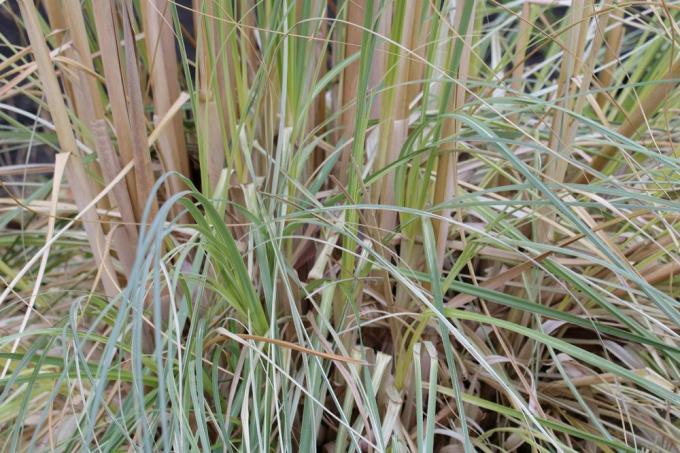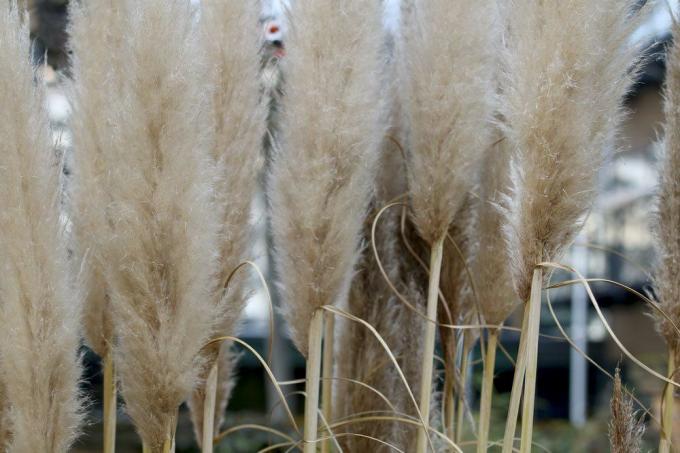
table of contents
- Overwinter
- Root protection
- Protect straws
- Winter quarters
- care
- Hibernate in the garden
Thanks to its magnificent fronds and long, narrow leaves, pampas grass is one of the most popular ornamental grasses and can be cultivated both in the garden and in the tub. It harmonizes with a wide variety of plants and garden styles, as a background plant or as a structuring agent in certain areas of the garden. While dwarf varieties measure almost a meter, other varieties reach heights of growth of up to three meters. And with the right packaging, they can get through the winter well.
Overwinter
Winter in a pot
Compared to protecting pampas grass in the garden, overwintering in a pot or bucket is much more difficult. The soil in the pot can freeze through relatively quickly without protection, which would lead to the death of the plant. It is all the more important to have good winter protection for the root area but also for the above-ground parts of the plant.
Root protection
In its natural environment, this ornamental grass thrives in hot and dry regions. It is not used to moisture and should therefore be protected from it as well as possible, especially in winter. In order to improve its winter hardiness, you should pay attention to a sufficiently large planter when planting, because the root needs a lot of space to spread and to develop dense and strong flower panicles and foliage can. The bigger it is the better.

- Place the bucket in a protected spot to protect the root area
- ideally in front of a warm house wall under a roof overhang
- Place on an insulating mat to protect against cold feet
- this can be an insulating styrofoam sheet, wooden slats or something similar
- Wrap the bucket yourself with bubble wrap, fleece, thick reed or coconut mats
- then cover the root area with straw or brushwood
In this way, the roots are optimally protected from the cold and, above all, from moisture, and adequate ventilation is also guaranteed. This type of protective measure affects potted plants in the garden as well as specimens that overwinter on the terrace or balcony. Around March / April, when stronger frosts are no longer expected, the cover can be removed.
Protect straws
Particular attention is paid to protecting the stalks or stalks. ensure that their insides stay dry. Under no circumstances should you prune them back in autumn, even if some of the stalks are already completely withered. Cutting back at this time would have fatal consequences; moisture could penetrate the hollow stalks unhindered. That in turn would lead to rot and cause the pampas grass to die off. Therefore, the above-ground parts must also be prepared for wintering.

- simply tie the stalks together loosely
- ideally bind in dry weather and when the grasses are dry
- If possible, do not tie up wet stalks
- Moisture could then not escape
- the stalks inside do not dry off and rot
Tip: When handling pampas grass, you should always wear long clothes, protective goggles and, above all, thick gloves. The leaf margins have razor-sharp saw teeth, which are easy to cut.

Winter quarters
The right place to overwinter
Depending on the local conditions, pampas grass in the bucket can also overwinter in a frost-free area. This can be particularly recommended in particularly wet and cold winters. The winter quarters should be as cool and light as possible, for example in a frost-free garage, shed, cellar or unheated winter garden.
Tip: Buckets of pampas grass are usually very heavy. So that they remain flexible and can be easily transported, it is advisable to place the tubs on a plant trolley from the start.

care
Care during the winter
Even if moisture is the main enemy of this plant, it occasionally needs to be supplied with water in winter. This is especially true for the plants that overwinter in protected areas.
- Bales should neither be wet nor dry out completely
- fertilizer can be dispensed with during the winter
- this applies to outdoor and potted plants
- next spring, around March, it will be time for pruning

Experts recommend doing this in two stages and first cutting down to about 20 cm. As soon as the new shoots appear, they can be cut back close to the ground without damaging the new shoots. But it shouldn't be wrong if you cut right down to the ground.
Hibernate in the garden
The pampas grass, originally native to South America, is used to cold winters and is relatively tough. Nevertheless, in our latitudes it needs protection from the cold and winter wet. This is particularly important in the garden, because here the ornamental grass is exposed to all weather conditions. It is often very humid, especially in winter, and a blanket of snow on the grass reinforces the whole thing. With younger grasses, it is particularly important to protect the root area with a cover made of fir branches that are piled up around the clumps. Foliage is less suitable; it could hinder or even prevent ventilation and promote rot.

Tie the straws together
As with potted plants, the stalks of the grasses that have been planted should be loosely tied together in autumn. Here it is all the more important to protect the heart inside the plant from moisture and extreme cold. By tying it together, a kind of closed roof is created, which acts as frost and moisture protection at the same time.
To do this, choose a day with dry weather and make sure that the stalks are dry. Since the weight of the bound leaves and stalks can be very large, it is advisable to stabilize them with a few supports that are driven into the ground. To protect against severe frosts, you can also wrap a fleece around the grass at the bottom. In this way, the pampas grass is completely protected from all the adversities of winter and can also produce numerous of its magnificent flower panicles in the next year.
